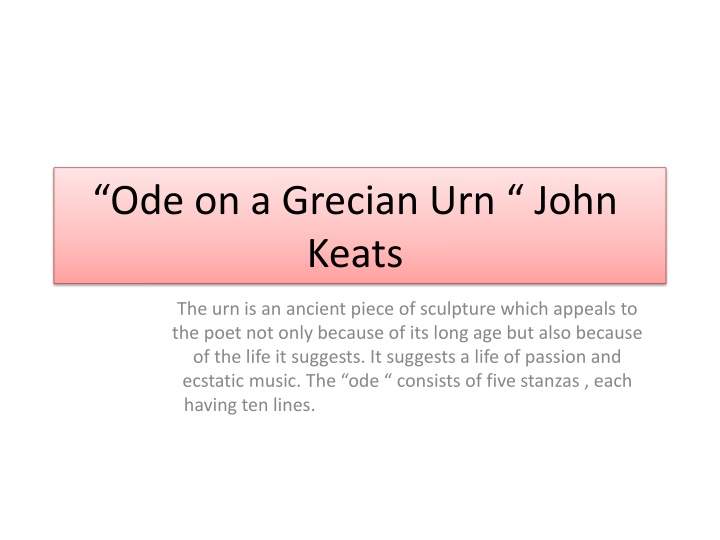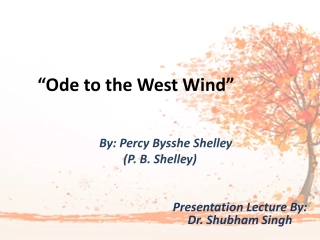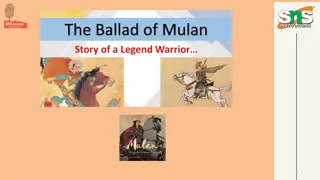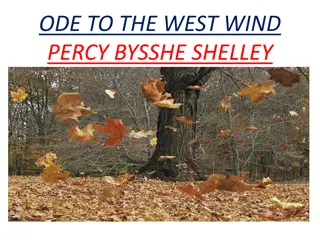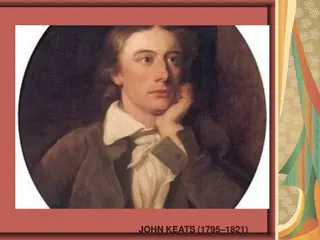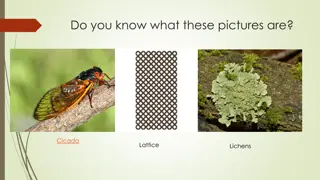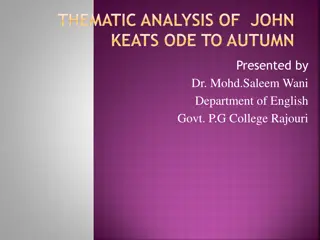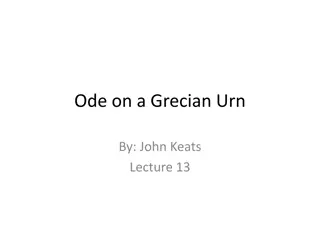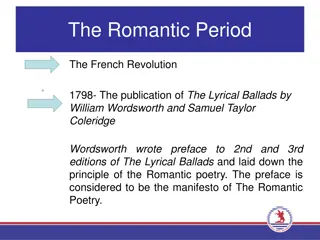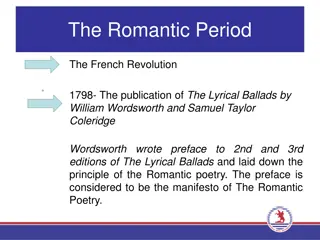Analysis of 'Ode on a Grecian Urn' by John Keats
Keats' 'Ode on a Grecian Urn' explores the timeless beauty and permanence of art compared to the transient nature of human life. Through vivid imagery and paradoxes, Keats delves into the themes of love, beauty, and the power of artistic representation. The urn, depicted as a silent storyteller, captures moments frozen in time, conveying a sense of eternal passion and unfulfilled desire. The poem reflects on the contrast between the fleeting nature of life and the enduring appeal of art, highlighting the immortality of artistic creations.
Download Presentation

Please find below an Image/Link to download the presentation.
The content on the website is provided AS IS for your information and personal use only. It may not be sold, licensed, or shared on other websites without obtaining consent from the author.If you encounter any issues during the download, it is possible that the publisher has removed the file from their server.
You are allowed to download the files provided on this website for personal or commercial use, subject to the condition that they are used lawfully. All files are the property of their respective owners.
The content on the website is provided AS IS for your information and personal use only. It may not be sold, licensed, or shared on other websites without obtaining consent from the author.
E N D
Presentation Transcript
Ode on a Grecian Urn John Keats The urn is an ancient piece of sculpture which appeals to the poet not only because of its long age but also because of the life it suggests. It suggests a life of passion and ecstatic music. The ode consists of five stanzas , each having ten lines.
Stanza 1 Keats employs metaphor when he calls the urn as unravished bride or a virginal bride because it has excited for centuries without undergoing any change. It is unravished as it sits quietly on a shelf or table . He also calls it a foster child because no body knows its parentage and time(personification) takes or adopts it as a foster child . The urn is called Sylvan historian because it records pastoral scenes from long ago . This historian supplies no names or dates but gives the actions of men or gods , of god like men or superhuman gods. The urn can tell a tale in form of pictures carved on it . It can tell a tale more powerfully than our rhyme. The urn is a powerful medium of communicating to us a flowery tale more sweetly than poetry can .Keats speculates that the scene is set either in Tempe or Arcady.
Stanza 2 The music we hear is actually sweet but the music we imagine is sweeter. Using paradox to open the second stanza , Keats praises the silent music coming from pipes and timbrels as far more pleasing than the audible music of real life, for the music of the urn is for the spirit. On the urn , Keats sees a handsome young man singing a song beneath the trees in a forest . The song of that handsome man can never come to an end . Nor will the leaves of these trees ever fall. Whenever we look at the urn , we shall see the young man singing his song , and we shall see the trees covered with their leaves . In actual life , a song must come to an end , and the leaves of the trees must ultimately decay and fall to the ground . But , in the case of the urn , the song will never end and the trees will never fall. The singer then is fixed in time like the leaves on the trees. He remains an etched figure on the urn .
Stanza 2 The poet also says that the bold young lover (who may be the piper or another person ) can never embrace the maiden next to him even though he is too close her . However , Keats says that the young man should not grieve for his lady s beauty will remain forever and their love though unfulfilled will continue through all eternity .In actual life , a young girl grows old with the passing of years and loses her beauty . Similarly , in actual life , the passion of lovers cools down soon after it is satisfied . But as far as the carving on the urn is concerned , the passion of lovers will always remain and the beauty of the beloved will never fade. Keats has contrasted the permanence of art with the transitory actual life. He asserts the supremacy of art over life. to
Stanza 3 The third stanza repeats some of the earlier ideas . The trees can not shed their leaves ; the untiring melodist and the ever passionate lover reappear . The musician plays sweeter music because he is unheard ( Paradox ) , but it is implied that he is not tired of the song for the same reason that the lover is not tired of his love : neither song nor love here can find fulfillment . The songs are forever new because they can not be completed . The paradox is also used in the case of the lover where love is forever warm because it is still to be enjoyed . The love depicted on the urn remains warm and young because it is not human flesh at all but cold ancient marble. The trees depicted on the urn are laden with leaves. It is time of spring . The leaves on the trees look fresh and its branches appear to be glad. The trees will enjoy an everlasting spring and they will never lose their trees. There is contrast to the trees which in real life must shed their leaves when spring comes to an end. Then , there is , on the urn , a musician playing his music . He will continue to play on his pipe forever without feeling tired. The tunes he is playing are forever fresh . In real life , a musician will at last feel tired and his tunes will come to an end.
Stanza 4 Another carving on the urn shows a procession going towards a place of worship in order to offer a sacrifice . The procession is headed by a priest who leads a young calf which is to be slaughtered for the sacrifice . The half open mouth of the calf makes it appear as if the animal were uttering low cries with its head up raised. The smooth sides of the body of the animal are decorated with garlands of flowers. The priest is called mysterious because nothing is known about his identity or religion . These lines contain the picture of a town the people of which have gone to an altar in order to offer a sacrifice . The poet imagines this town is situated close to a river , or on a sea shore , or at the foot of a hill or the top of which stands a fortress. The town is empty because it is a holy morning and the people have left to offer a sacrifice . The carving on the urn shows people going to the altar , but not returning to town . Whenever we look at the carving we shall see people going away from the town but never returning. This means that the streets of the town will remain silent and empty . Not a single individual will ever be seen returning to the town to tell why the town is empty and lifeless(contrast between art and real life ).
Stanza 5 As the urn belongs to Greece , the poet addresses it as Attic shape meaning a piece of Greek art .It is a beautiful work of art with several scenes carved on it . The poet calls it fair attitude to convey the beauty of this work of art . The marble urn has been decorated with carvings of men and maidens . There are some rural scenes on the urn showing weeds which have been trampled upon . It teases us out of the actual into an ideal world of art (permanence &beauty ).By comparing the urn to eternity , the poet reinforces its value as a symbol of permanence and it has the capacity to divert our attention from thinking. Although one generation of suffering human beings will be replaced by another and so on over the years , the urn will continue to exist as it is . The urn will continue as unchanging thing of beauty in the midst of the changing sorrows of rising and passing generation s. Whatever is beautiful must also be true ; and whatever is true must also be beautiful . Thus beauty and truth are inseparable . This knowledge is more than enough for the urn to tell and for human beings to learn.
